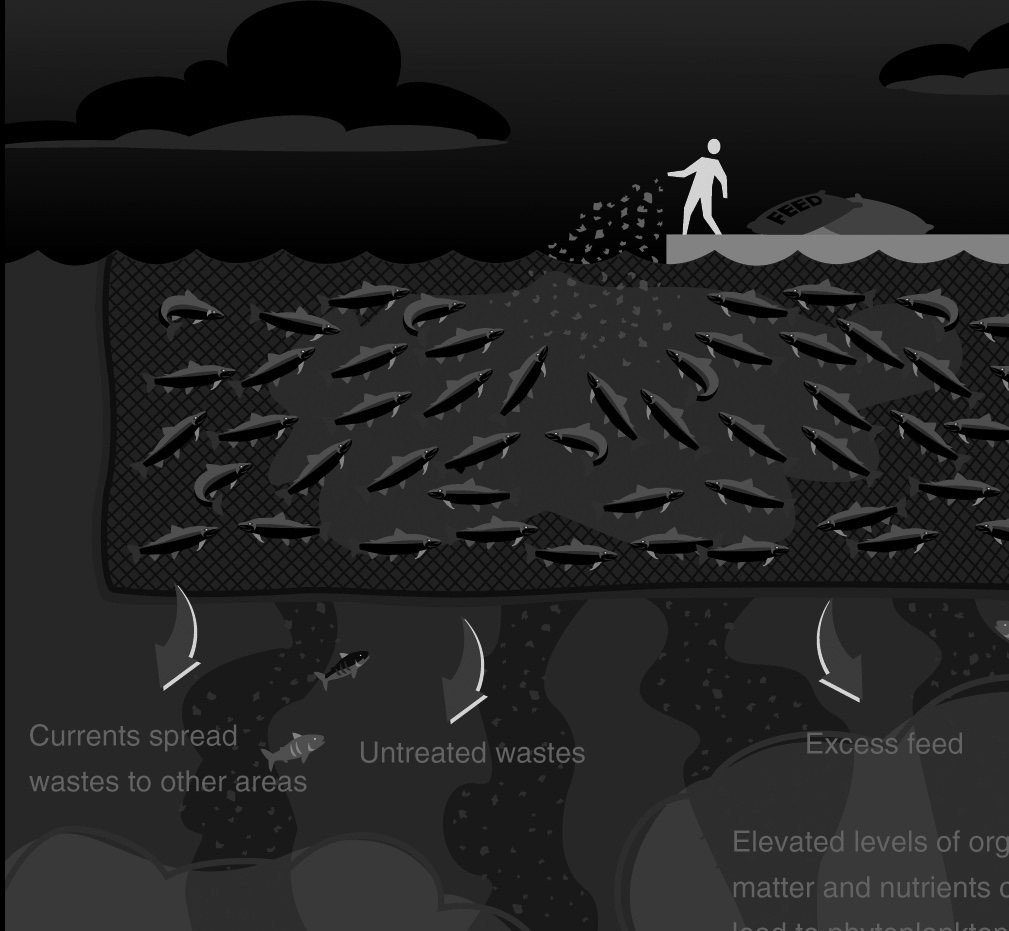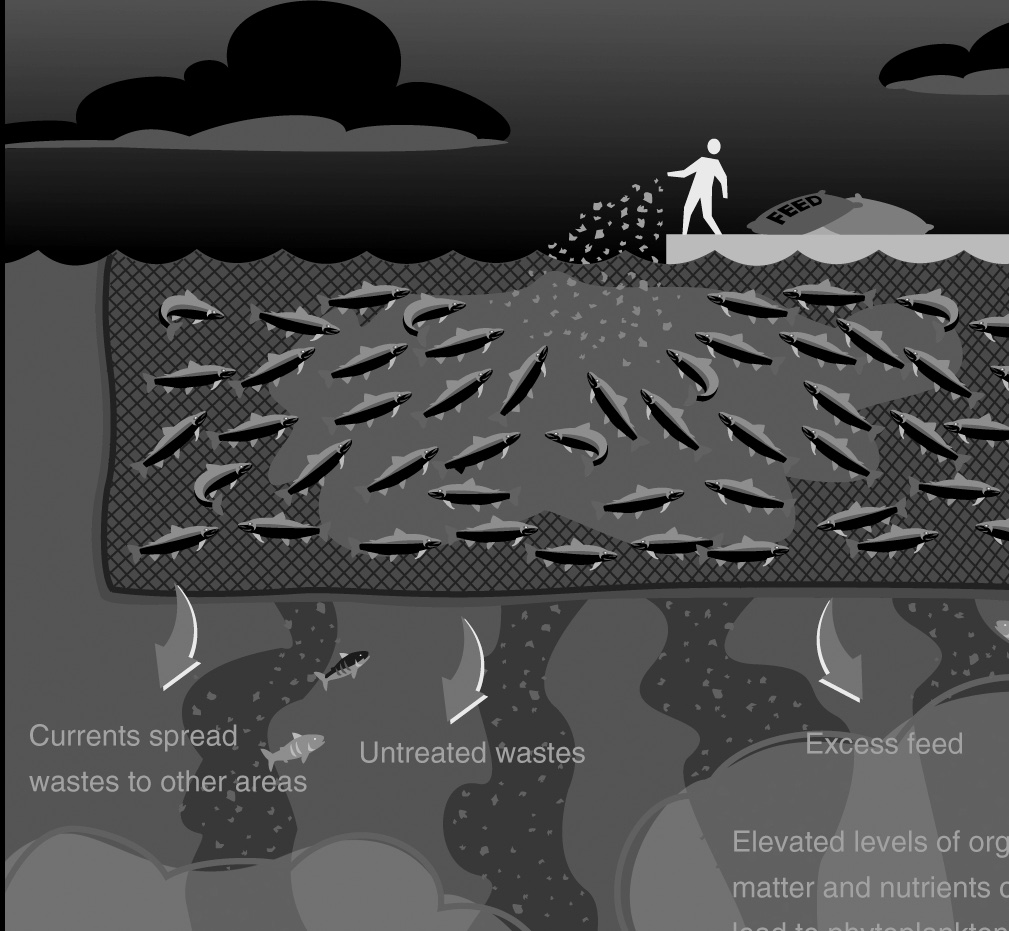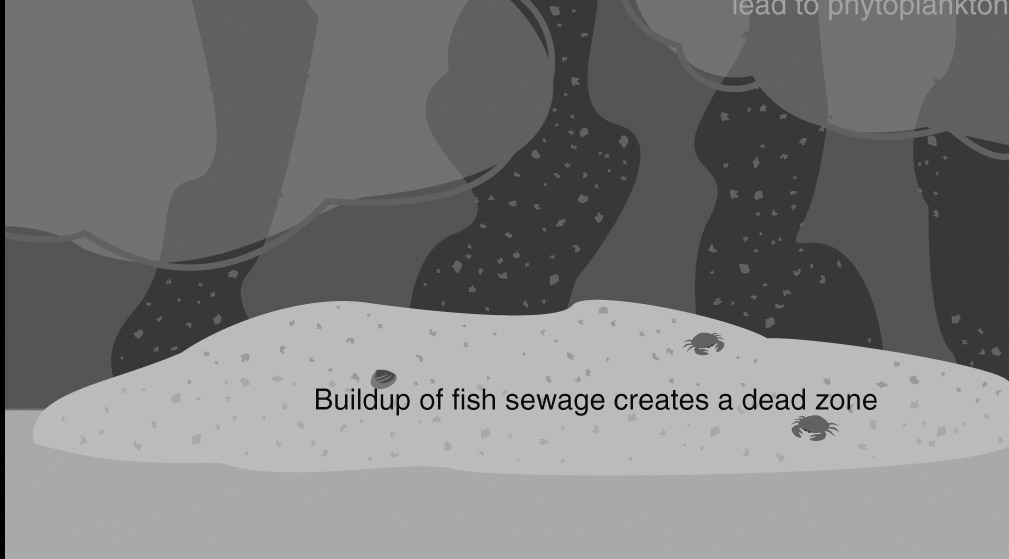410-06-03waste.indd
WASTE CONTAMINATION FROM SALMON FARMS Tens of thousands of farmed salmon confined to net pens produce a huge amount of waste: chemical, biological, organic, and inorganic. For more than 25 years, researchers around the world have recognized the harm from salmon farm waste and its long-term impacts on water quality, fisheries resources, and sea-bed ecology.1 THE WASTE PROBLEMSalmon net pens discharge untreated sewage, including contaminated feed laced with chemi-cals, toxic residues, nitrogen, phosphorus, and copper and zinc—not to mention diseases and parasites—directly into coastal waters throughout the world. In addition, tons of contaminated salmon, together with processing wastes—bones, entrails, and even the carcasses of seals, sea lions, and other predators—are dumped in landfills or processed for fertilizer or animal feed. Sewer Systems in the SeaExperts have calculated that factory salmon farms, each extending over several acres of coastal waters, discharge extremely high concentrations of untreated sewage. • According to Scotland's World Wildlife Fund, salmon farms there produce nitrogen wastes equal to a human population of more than nine million people.2 Even industry insiders concede that a typical 200,000-fish salmon farm releases: • nitrogen equal to 20,000 humans, • phosphorus equal to 25,000 humans, and • fecal matter roughly equivalent to a city of 65,000 people.3 In 2000 and 2001, nutrient discharges from aquaculture in the Northeast Atlantic, including Scot-land, Denmark, Norway, and Ireland, were estimated at almost 40,000 tons of nitrogen and 6,600 tons of phosphorus.4 Pollution from NutrientsSewage and other wastes from salmon farming causes far-reaching environmental harm by: • contaminating the sea-bed and its shellfish species, • contributing to the antibiotic resistance of shellfish and wild fish, and • causing eutrophication that triggers toxic algal blooms.The accumulation of sewage on the seafloor under and around salmon farms directly harms marine biodiversity. Scientists in Scotland, Norway, Ireland, and Canada have all shown that some PURE SALMON CAMPAIGN • www.puresalmon.org






of these effects may last several years and extend for several hundred meters away from salmon farm.5 Divers have also found biological "dead zones" under salmon farms—areas on the sea-bed devoid of marine life. This problem is so prevalent that every few years salmon farmers relocate their net pens to prevent the sea-bed from completely dying. As a result, salmon farms are gradu-ally moving further offshore and contaminating a larger area of once healthy water.
Pollution from Chemicals Salmon farm sewage often contains chemicals
Waste Stream Pollution From Farming Fish In Net Pens
and contaminants6 that easily enter the food chain and accumulate as they move up it, ulti-mately reaching humans. Among these chemi-cals are:
• tributyltin, a fungicide
• oxytetracycline and oxolinic acid, both antibiotics
• ivermectin, an anti-parasite compound
• emamectin benzoate, cypermethrin, azame-
thiphos tefl ubenzuron, and dichlorvos—all insecticides.
• polychlorinated biphenyls (PCBs).7
The abuse of antibiotics by large salmon farming operations has not only led to chemical resistance in wild fi sh species but also raised health concerns
Graphic: Rick Shiers
for humans whose diets already include milk, eggs, and meat products containing unknown amounts of similar drugs.8
Pollution from Mass MortalitiesMassive farmed salmon deaths (euphemistically referred to as "morts" in the industry) add to the burden of pollution from commercial salmon farms. Industry-wide, mortality rates in factory salmon operations range from 10 percent to 40 percent. Outbreaks of infectious diseases, such as Infec-tious Salmon Anaemia, may necessitate the slaughter of 100 percent of a farm's stock, as it did in Scotland in 1998-99 when eight million fi sh had to be killed to stem the spread of disease.
The sheer volume of dead fi sh can only be measured in tons. In British Columbia, for example, where factory farms produce 70,000 tons of salmon annually, an estimated 20,000 tons of dead fi sh have to be discarded each year. Globally, production of almost 1.9 million tons of salmon pro-duces a disposal problem for several thousand tons of dead and dying salmon.
In many parts of the world, thousands of tons of dead farmed salmon are dumped every year in landfi lls. Because most salmon farms are in remote locations, dead fi sh are often expediently dumped in isolated areas rather than farmers paying to ship the waste to legitimate treatment sites. In Scotland, for example, one company was caught dumping thousands of disease-suspected farmed salmon on an environmentally sensitive beach.9
PURE SALMON CAMPAIGN • www.puresalmon.org
Alternative disposal methods involve depositing fish in large silos and applying chemicals to has-ten decomposition. Dead salmon, some diseased and others contaminated with chemicals, may also be used by farmers for fertilizer or converted to compost and applied to farms and gardens. Still other salmon "morts" end up in pet food or as feed on mink farms.
CLOSING THE NET ON WASTE Alternatives to irresponsible dumping and waste discharge have been tried for several years. Scotland's Environmental Protection Agency experimented with various systems until the late 1990s when it yielded to industry pressure and concluded that the cost of requiring new technologies was "not viable for commercial salmon production under present economic conditions." Similar studies in Canada, with treatments for waste water from salmon farms, were also declared "uneco-nomic" and discontinued.10
Although dead salmon and their wastes can be safely disposed of with various filtration and treatment systems to protect marine ecosystems, the salmon farming industry has resisted all such proposals in the interest of keeping costs low to offer the cheapest product possible. The savings to consumers, however, means a far heavier price must be paid by wild salmon, the shellfish industry, and traditional commercial fishing livelihoods. More to the point, no one yet knows the true cost of cheap farmed salmon to human health.
1 S. J. Cripps and L. A. Kelly, "Reductions in wastes from aquaculture," In D. J. Baird et al. (eds.), Aquaculture and water resource management, Black-
well Science, Oxford, 1996. See also J. R. Henderson et al., "The lipid composition of sealoch sediments underlying salmon cages," Aquaculture, 158:69 (1997), pp. 83-89.
2 M. MacGarvin, "Scotland's secret? Aquaculture, nutrient pollution, eutrophication and toxic algal blooms," WWF Scotland, Aberfeldy (2000), <www.
3 R. W. Hardy, "Urban legends and fish nutrition," Aquaculture Magazine, Nov/Dec (2000), <www.aquaculturemag.com/siteenglish/printed/archives/
4 Scottish Executive, "Eutrophication assessment of aquaculture hotspots in Scottish coastal waters," Paper presented to OSPAR by the Scottish Execu-
tive, May 2003, <www.ospar.org>.
5 D. J. Wildish et al., "Acoustic detection of organic enrichment in sediments at a salmon farm is confirmed by independent groundtruthing methods,"
Marine Ecology Progress Series 267 (2004), pp. 99-105, <www.int-res.com/abstracts/meps/v267/p99-105.html>.
6 K. Haya, "Environmental impacts of chemical wastes produced by the salmon aquaculture industry," In B. T. Hargrave [ed.]. Environmental Studies for
Sustainable Aquaculture 2002 Workshop Report, (Canadian Technical Report), Canadian Bulletin of Fisheries and Aquatic Sciences, 2411 (2002), <www.mar.dfo-mpo.gc.ca/science/mesd/publications/pubs-f.html>.
7 P. W. Balls, "Tributyltin (TBT) in the waters of a Scottish sea loch arising from the use of antifoulant treatment netted by salmon farms," Aquaculture, 86
(1987), pp. 227–237.
8 C. D. Miranda et al., "Diversity of tetracycline resistance genes in bacteria from Chilean salmon farms," Antimicrobial Agents and Chemotherapy 47
(2003), pp. 883–888, <http://aac.asm.org/cgi/content/abstract/47/3/883>.
9 "Fears raised by salmon dump," The Sunday Times, July 17, 2004, posted on "Aquaculture Corner," of the Mangrove Action Project, <www.earthisland.
10 G3 Consulting, Salmon Aquaculture Waste Management Review & Update, Report prepared for British Columbia Ministry of Environment, Lands
PURE SALMON CAMPAIGN • www.puresalmon.org
Source: http://nsapes.ca/sites/default/files/attachments/waste_0.pdf
Regulation of pharmaceutical markets in germany: improving efficiency and controlling expenditures
Managing pharmaceutical regulation in Germany: overview and economic assessment Jonas Schreyögg, Klaus-Dirk Henke, Reinhard Busse Abstract Rising costs in pharmaceutical expenditure have become a major concern for policy makers in Germany over the last years. Therefore the pharmaceutical market in Germany has been increasingly targeted by different kinds of regulations, focussing
Microsoft word - dekieffer 1.6 _eic final_.doc
American Journal of Law & Medicine, 32 (2006): 325-349 © 2006 American Society of Law, Medicine & Ethics Boston University School of Law Trojan Drugs: Counterfeit and Mislabeled Pharmaceuticals in the Legitimate Market Donald deKieffer† Over the past five years, there have been over 140 reported incidents of counterfeit and mislabeled drugs being sold by legitimate pharmacies in the United States.1 Thousands of patients have consumed these medications, sometimes with dire consequences.2 The extent of counterfeits in the legitimate market, however, is unknown. It is certain that the detected incidents of fakes are a fraction of the total number of incidents.3